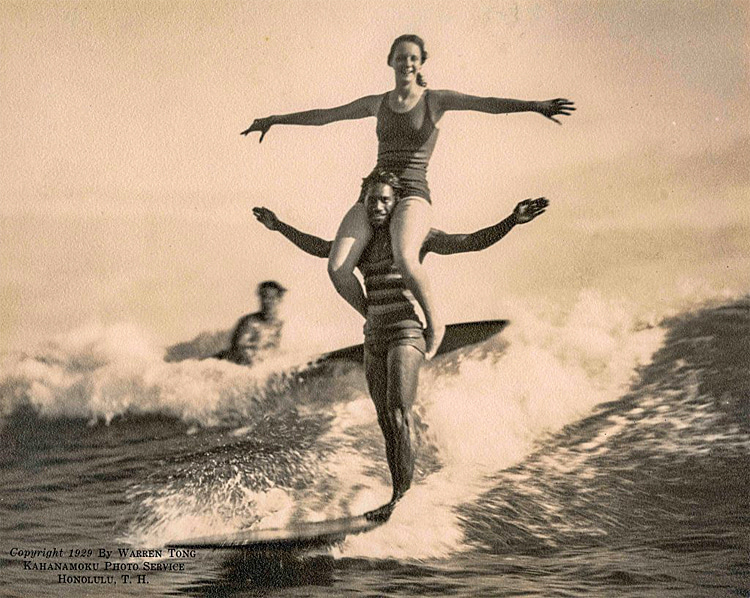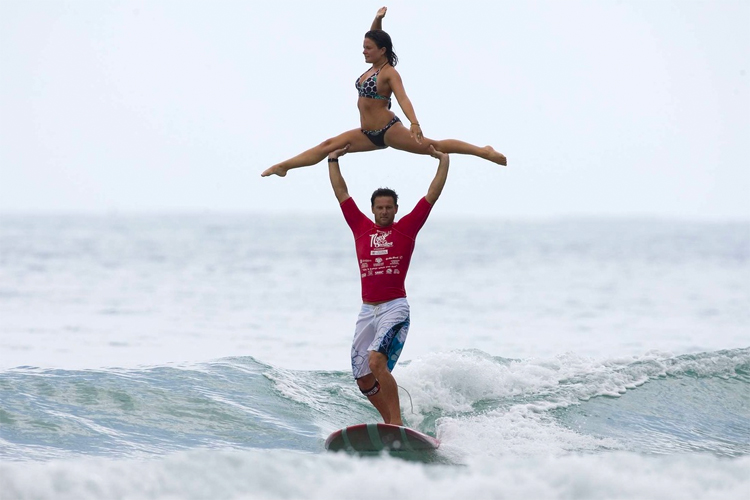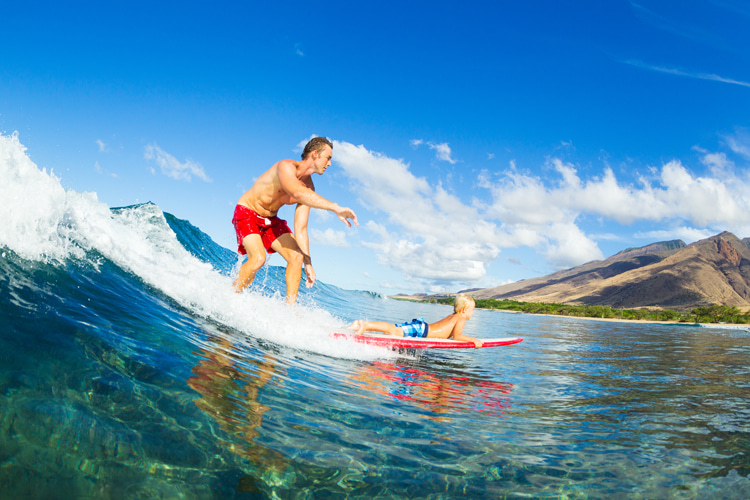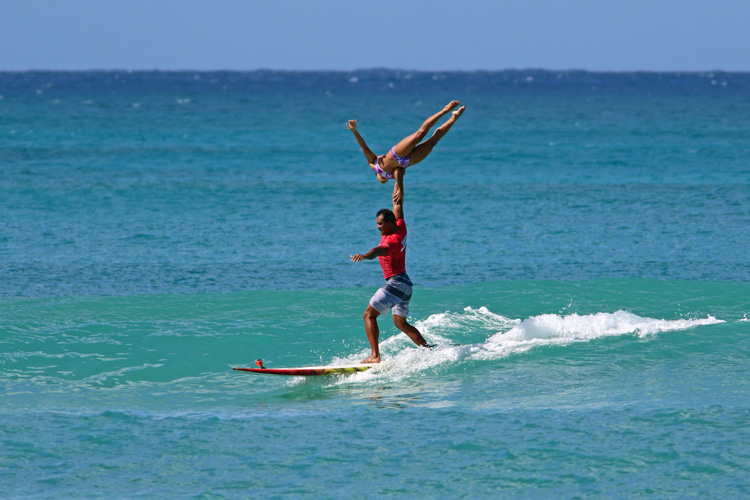Tandem surfing is a fun and exciting way to surf with a partner. Here's how to transform wave-riding into a team sport.
Good communication skills and compatibility with your teammate are important in any relationship, including a tandem surfing partnership.
Both partners should have similar goals, whether it's just surfing for fun or competing professionally.
While some couples tandem surf together, most teams are made up of individuals who have their own families or significant others who support their partnership.
This team sport involves close physical contact and shared responsibility, so finding someone you trust and feel comfortable with is important.
You can also go surfing with your children or friends but, ultimately, it's up to you to decide what kind of connection you want.
Here are some general steps to get started:

1. Find a Partner
Tandem surfing requires two people, so find someone interested in learning and practicing with you.
Male
When looking for a male partner to tandem surf with, it's important to find someone who is a good surfer with experience with different wave types.
They should be strong so that they can lift you high above their head, but they don't need to be able to do fancy tricks right away.
If you're a beginner, you can learn these skills later.
The best way to find a male tandem teammate is to look for someone already out in the water surfing.
Female
When looking for a female partner to go tandem surfing, finding someone who is athletic and on the smaller side is helpful.
It's even better if they have some experience in activities like acrobatics, gymnastics, dance, cheerleading, or yoga.
Professional female teammates are usually under 5'2'' and around 110 pounds, but it's more important to find someone with acrobatic skills rather than just being small.
For beginners, surfing experience isn't required, but it's helpful if they have experience in the water and feel comfortable in the ocean.
Some good places to find a female partner might be at a dance studio, gym, or acro-yoga groups.

2. Choose the Right Board
Tandem surfboards are bigger than regular longboards because they have to support the weight of two people and be stable enough for lifting while still being able to move around on the waves.
So, choosing a board that is large enough for both of you to stand on together comfortably is mandatory.
The size of the board depends on how much the team weighs, the types of waves they'll be surfing, and what they want to do on the board.
Some teams want to be able to do more tricks, while others want more stability. They might want a board with more rocker at the front if they're surfing bigger waves.
The fins on the board can be set up differently, but most teams just use one.
The type of material used to make the board, either fiberglass or epoxy, is a matter of personal preference.
Most professional tandem teams use custom-made boards nowadays, but in the past, the top teams used an 11'6'' long, 29 inches wide, and 4 7/8 inches thick C4 Waterman model.
It was available worldwide at the time and easy to get at competitions, so teams didn't have to bring their own boards.
Note that most airlines won't let you bring your tandem board with you because it's too big, or they'll charge a lot of money to check it as baggage.
Some teams choose to ship their boards ahead of time for competitions.
Here are some of the models used by the world's best tandem surfing duos:
- Chuck Inman and Lauren Oiye (HAW): 11'9'' long x 27'' wide x 4.5'' thick;
- Rico Leroy and Sarah Burel (FRA): 11'6'' long x 29'' wide x 4'' thick;
- Clement Cetran and Dhelia Cetran (FRA): 11'2'' long x 28'' wide x 3 3/4'' thick;
- Leleo Kinimaka and Megan Talabis Anderson (HAW): 11'4'' long x 27'' wide x 4'' thick;
- Brian McEvilly and Illa McEvilly (USA): 11' long x 26.5'' wide x 4.25'' thick;
- Travis Long and Ahlia Hoffman (USA): 11'10'' long x 27'' wide x 5'' thick;
- Bobby Friedman and Breana Schroeder (USA): 12' long x 27'' wide x 4'' thick;
3. Pick the Right Spot
Choose a spot with gentle waves and enough space for you to practice without getting in the way of other surfers.
Make sure to start on the beach.
Practice your positioning and movements on the beach before entering the water.
Stand facing each other with your arms around each other's waists, then shift your weight back and forth as if you were riding a wave.
4. Ride and Practice
Once the tandem surfing duo feels ready and comfortable with their movements, it's time to hit the water and paddle out together.
When you spot a good wave, paddle together to catch it.
As you approach the wave, the person in the back should paddle harder to propel you both forward.
As the wave lifts the board, you should stand up together.
The person in the back should control the board's direction by shifting their weight, while the person in front maintains balance.
Once the duo is fully accustomed to the take-off and pop-up techniques, they can try some simple acrobatics.
Here are the main lifts and maneuvers and the correspondent scoring, sorted from easy to hard:
- Cradle: 0,5
- Fish: 0,5
- Shoulder Sit: 0,5
- Knee Stand: 0,6
- Nalu: 0,6
- Reverse Knee Stand: 0,6
- Shoulder Swan: 0,6
- Hand Knee Stand: 0,7
- One Leg Knee Arch: 0,7
- One Leg Knee Stand: 0,7
- Pinwheel: 0,7
- FAA: 0,8
- Fake High Stag: 0,8
- Falling Angel: 0,8
- Pop: 0,8
- Grass Shack: 0,9
- High Reverse Stag: 0,9
- Neck Roll: 0,9
- Shoulder Stand: 0,9
- Camel: 1,0
- One Arm Back: 1,0
- Side Bird: 1,0
- High Stag: 1,1
- One Leg Shoulder Stand: 1,1
- Ploc: 1,1
- Falcon: 1,2
- Kennedy: 1,2
- Totem: 1,2
- Arabesque: 1,3
- Arabesque Stand: 1,3
- Heel Stretch Stand: 1,3
- Front Angel: 1,4
- High Swan: 1,4
- One Arm Falcon: 1,4
- Attitude: 1,5
- Halo: 1,5
- Perch: 1,5
- Hurdler: 1,6
- Small Arrow: 1,6
- Statue: 1,6
- Buddha: 1,7
- Foot to Head: 1,7
- Helicopter: 1,7
- Americano: 1,8
- Back Angel: 1,8
- One Arm Kennedy: 1,8
- Atlas: 1,9
- Big Arrow: 1,9
- Pyramid: 1,9
- Front Arch Split: 2,0
- One Arm Statue: 2,0
- Straddle: 2,0
- Butterfly: 2,2
- Pendulum: 2,2
- Star: 2,2
- Arm to Arm: 2,4
- Contortion: 2,4
- Needle Stand: 2,4
- Cobra: 2,6
- Flat: 2,6
- Pike: 2,6
- Acro: 2,8
- Puka: 2,8
- Scorpion: 2,8
- Y Arm to Arm: 3,0
- Foot to Hand: 3,0
- One Arm Straddle: 3,3
- Split Acro: 3,3
In the end, the secret to progression is practice.
So remember to practice on a regular basis, and don't be afraid to make mistakes.
Tandem surfing requires coordination and communication between partners. Have fun and enjoy the ride together.
Follow the International Tandem Surfing Association (ITSA) events for more tips on how to become a better wave-riding team.

Extra: Surfing with Children
Before you and your child paddle into any waves, it's important to practice in calm, flat water first.
Begin by paddling your child around and help them get used to being on the board. Show them how to lie down and practice balancing.
Teach them how to move their arms and cup their hands for paddling. When they feel ready, encourage them to stand up and jump off the board.
Are you feeling ready to catch some waves together? Perfect.
First, position them closer to the front of the board while you paddle out.
Teach them to hold on tight and close their mouths when you go over the waves to avoid falling off or getting water in their throats.
You can also boost the kid over the white water parts, making the front of the board fly into the air and crash down the back of the wave.
For that, the young gun must hold on tight. But it's generally fun.
Finally, let your child get comfortable riding the board, and when they're ready, you can kneel and help them stand up on the whitewater.
To prevent young children from getting scared of water splashing in their faces, try placing them facing backward on the board while paddling into a wave.
When you pop up, your child can hold onto your shoulders or chest for support, making it easier for you to carry them during the ride.
If you need to fall off the board with your child, it's best to fall off the back of the wave.
When you come up to the surface, use your arm to protect both heads in case the board flies towards you.
Last but not least, make it a fun experience. If the child is not happy or feeling uncomfortable, call it a day.
